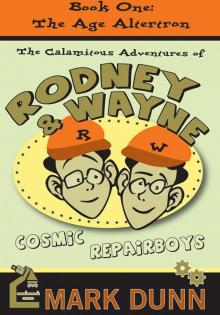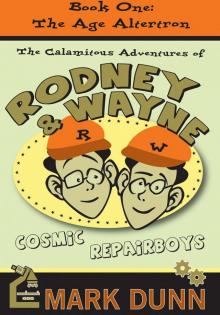American Decameron Read online
First published in 2012 by M P Publishing Limited
6 Petaluma Blvd. North, Suite B6, Petaluma, CA 94952
12 Strathallan Crescent, Douglas, Isle of Man IM2 4NR
1 3 5 7 9 10 8 6 4 2
Copyright © Mark Dunn
Mark Dunn asserts his moral rights to be identified as the author
Jacket by Iain Morris
Typeset by Maria Clare Smith
Dunn, Mark, 1956-
American decameron / Mark Dunn.
p. cm.
ISBN 978-1849821636 (Hardcover)
ISBN 978-1-84982-253-4 (e-book)
1. Short stories, American. 3. Short stories. 3. United States --Social life and customs --Fiction. 4. United States --History --20th century --Fiction. I. Title.
PS3604.U56 A44 2012
813/.54 --dc23
A CPI Catalogue for this title is also available from the British Library
This book is sold subject to the condition that it shall not, by way of trade or otherwise, be lent, resold, hired out, or otherwise circulated without the publisher’s prior consent in any form of binding or cover other than that in which it is published and without a similar condition including this condition being imposed on the subsequent purchaser.
The scanning, uploading and distribution of this book via the internet or via any other means without the permission of the publisher is illegal and punishable by law. Please purchase only authorized electronic editions and do not participate in or encourage electronic piracy of copyrighted materials. Your support of the author’s rights is very much appreciated.
AMERICAN
DECAMERON
MARK DUNN
For my nephews (who remain little boys in my heart):
Daris, Ryan, Bren, and Zach,
and to the memory of Chris, the little boy who left us too soon
CONTENTS
1901 Arboreal in Texas
1902 Vehicular in New York
1903 Deductive in Michigan
1904 In Memoriam in Pennsylvania
1905 Genealogical in Rhode Island
1906 Punch(ing) Drunk in Pennsylvania
1907 Problematically Betrothed in Massachusetts
1908 Volant in North Corolina
1909 Morbific in New York
1910 Porcine in North Carolina
1911 Efflorescent in Maine
1912 Triskaphobic in Wisconsin
1913 Clairvoyant in New York
1914 Devotional in Illinois
1915 Having a Sinking Feeling in the North Atlantic
1916 Incarcerated in Oklahoma
1917 Principled in Massachusetts
1918 Trepid in France
1919 Vestal in North Dakota
1920 Filial in Tennessee
1921 Composed (?) in Oregon
1922 Cineastic in Arkansas
1923 Conspiratorial in North Carolina
1924 Double Faulted in Illinois and D.C.
1925 Acrophilic and Agoraphobic in Pennsylvania
1926 Between the Hammer and the Anvil in Kentucky
1927 Assisian in Massachusetts
1928 Misdeemed in Indiana
1929 Taking a Dim View in Michigan
1930 Without Apron Strings in Delaware
1931 Awed and Wondering in Connecticut
1932 Fascistic in D.C.
1933 Letting Go in Missouri
1934 Adulterous in Illinois
1935 Perseveringly Terpsichorean in Washington State
1936 Shabby-Genteel in California
1937 Depilated in Ohio
1938 Jiving in Nebraska
1939 Galactophorous in Virginia
1940 Au Fait in Colorado, New Mexico, and California
1941 Under attack in Hawaii
1942 Cerulean in Wisconsin
1943 Telegraphic in Iowa
1944 Sequestered in New Mexico
1945 Hypernatremic in the Pacific Ocean
1946 Enneadic in Iowa
1947 Racist in Tennessee
1948 Haunted in Connecticut
1949 Ball Changing in Mississippi
1950 Poikilothermal in West Virginia
1951 Psitticine in Pennsylvania
1952 Doubly Uxoricidal in Colorado
1953 Pharisaical in Wyoming
1954 Famished in Texas
1955 Agitated in Alabama
1956 Discreetly Silent in Montana
1957 Loyal in Utah
1958 Explosive in South Carolina
1959 Tight in New York
1960 Smiling in California
1961 Unliterate in New Hampshire
1962 Thrown a Curve Ball in New York
1963 Estivating in New Jersey
1964 Nearly Interred in Alaska
1965 Mistrysted in New York
1966 Outraged in Idaho
1967 Going the Vole in Nevada
1968 Hieratic in Kansas
1969 Parental in Arizona
1970 Skirting the Issue in West Virginia
1971 Bibliophilic in Alabama
1972 Precipitate in Illinois
1973 Vengeful in Maryland
1974 Vicinal in Tennessee
1975 Physically Candid in Louisiana
1976 Throttled in Arkansas and Oklahoma
1977 Rectally Remunerative in Illinois
1978 Tri-Toasted in Missouri
1979 Going Through the Mill in Texas
1980 Renovative in Texas
1981 Self-Anointed Above, Let’s Say, Oklahoma
1982 Reunited in Missouri
1983 Etched in Stone in Washington, D.C.
1984 Patriarchal in California
1985 Smitten in Wisconsin and Minnesota
1986 Locked Out in Texas
1987 Motherly in Georgia
1988 Stouthearted in Florida
1989 Melodious in Ohio
1990 Gerontoconcupiscent in Vermont
1991 Filicidal in Mississippi
1992 Grieving in Minnesota
1993 Shelved in New Mexico
1994 Crooning and Swooning in South Dakota
1995 Variously Bereft in Minnesota, California, Oklahoma and Montana
1996 Coprophobic in Mississippi
1997 Combustible in Ohio
1998 Dentigerously Fortuitous in Florida
1999 Constructive in Botswana
2000 Convergent in Connecticut
INTRODUCTION
As its title suggests, American Decameron is comprised of one hundred short stories, each either set in the United States or featuring Americans in far-flung places, and each assigned to a different year of the twentieth century, which historians often refer to as “the American Century.” Although the stories here are presented chronologically, it isn’t necessary for them to be read sequentially, with the exceptions of “1901: Arboreal in Texas,” and “2000: Convergent in Connecticut,” which serve as prologue and epilogue for the book and should be read first and last, respectively.
The stories, though discrete in terms of time and place, tone and subject matter, are complementary components of a singular journey through the century now past. Together, the one hundred different narratives create a patchwork of American life in an era that seems at times familiar, at other times wholly archaic compared to the way we live our lives today.
While it was never my intention to write a different story on every aspect of life in the United States during the twentieth century (although I have achieved my personal goal of setting at least one story in each of the fifty states of our union and Washington, D.C.), I have tried very hard not to tell the same story twice. Some of my stories are subversive, and with a tip of the auctorial hat to Mr. Boccaccio, who penned the original Decameron in the fourteenth century, I
have even dropped a handful of purposefully naughty tales into the mix. (Parents and teachers are advised to preview a story before sharing it with a young reader.)
Obviously, these stories are greatly informed by my own interests. On the other hand, I’ve made a deliberate effort to expand those interests so as to be as catholic as possible. My goal has always been to create a work of fiction that my readers will enjoy both for its uniqueness (Günter Grass’s My Century, published in 1999, is constructed upon a similar concept, but is laid out with intentional economy; few of Grass’s one hundred historic and social portraits of Germany through the past century are longer than three pages), as well as for the worth of its individual constituent stories.
Although fantasy, the occult, and science fiction have always interested me, these are literary genres you’ll have to seek elsewhere. American Decameron is about people who either really existed in that bygone century, or could have existed. All of my characters’ feet are planted firmly (if sometimes a bit unsteadily) on terra firma. (The two literal exceptions would be 1915 and 1945, which take place in the Atlantic and Pacific oceans, respectively.) If you have any doubt as to which category a character in a particular story belongs—real or not real—do the twenty-first century thing: Google him. I have not been at all shy about appropriating flesh-and-blood historical personages to use as characters in my stories.
A good rule of thumb here: If something sounds too incredible to be believed, it probably really happened.
And if you end up enjoying this book half as much as I enjoyed writing it, then I’ll be a happy man indeed. You might even encourage me to try my hand at the nineteenth century. (Did I actually say that?)
Mark Dunn
1901
ARBOREAL IN TEXAS
Gail Hoyt came into this world on March 1, 1900. There being no Galveston County Records Office at the time, scrawled mention of her birth appears only in the baptismal ledger of the church where her father and mother worshipped, Tremont Ecumenical Chapel. The minister, stubbornly insistent that 1900 was a leap year just as was every other year divisible by four, inked next to her name the date February 29, 1900.
The minister was wrong. There was no leap day in 1900.
Gail Hoyt nearly left this world that same year on the occasion of the Great Galveston Hurricane, which blew in with historic fury and killed thousands of Gail’s fellow Galvestonians—including both of her parents. The swaddled child was deposited high within the brachial embrace of a storm-denuded live oak tree. Perhaps it was not the storm itself that placed her there; hurricanes have personalities far less mercurial than tornadoes, which have been known in their more erratic moments to transport babies—unscathed—to all manner of remarkable resting places. More than likely it was someone who did it—someone who perhaps had escaped the rising floodwaters with the little girl tucked under arm, only to be whisked by wind or wave into oblivion.
Much has been written about the Great Galveston Hurricane. And no small measure of ink and typewriter ribbon carbon has also been devoted to the “Rock-a-bye Girl,” as she would soon and ever thereafter be called—a girl who from that point forward was to spend her life ascending things, and gazing down at the world from great heights. Like the sailor who rejected solid ground for the constant pitch and roll of the restless sea, Gail Hoyt sought the vault of the sky and the bird’s-eye view, some special, lofty aerie to call her own.
The Rock-a-bye Girl would grow up to turn her love of the towering and the altitudinous into both vocation and avocation. There would be very few men in her life capable of climbing to such heights as she, but those who did make the brave ascent found favor in Gail’s embracing arms. Two in particular won Gail’s heart for a time: a circus tightrope walker and a celebrated aviator. There was another man whom she coaxed to the top of flagpoles in the madcap twenties, but he plummeted with the stock market, the loss of his family nest egg sending him into a swan dive over the pavement of Upper West Side Manhattan.
High upon cliffs and hilltops and towers Gail exalted herself, for the young woman had no fear of falling—none whatsoever. She was human avatar for a nation that was also on the ascension—a country that sought to climb and clamber its way up through this new century to sublime heights of its own.
“Born with the century,” said Mrs. Pell, administrator of the Seaside Home for Storm-orphaned Girls, an institution of that woman’s recent founding. “And she will grow old with that very same century—the American Century. Don’t you agree, my little Rock-a-bye Girl?” Mrs. Pell nuzzled the baby, nose to nose like a Maori, and then lifted her from the crib she shared with two other orphaned girls of nearly the same age and unfortunate circumstances. As Mrs. Pell raised Gail high above her head, the child—who had been sluggish and largely unresponsive—curled her little lips into a simper of infant delight, and before Mrs. Pell could put her down, was giggling in bubbly bursts of baby glee. Perhaps Gail was imagining in her tiny inchoate brain that she was a bird taking wing (for there was a recurring pattern of birds in flight upon the wallpaper in the room). Overhead was a gasolier and Gail reached for it, as if she might swing monkey-like from its brass hardware.
“What an extraordinary child!” marveled Miss Falcongentle, assistant to Mrs. Pell, as she took the baby from her middle-aged employeress and held her aloft as well. And all was fine and gay on that day in early 1901 when Gail was just ten months old. That day would shine in sharp contrast to the one that came later in the year—a day that would send Gail upon a very different path than Mrs. Pell had first sought for her.
But let us tarry for a few moments longer on that day upon which Gail made infant claim upon the supernal: January 2, 1901, which—depending upon which side of the table in the Seaside Home for Storm-orphaned Girls’ dining room one sat—was either the second day of the new century or the three-hundred and sixty-seventh.
The case for the former was made by Mrs. Pell’s suitor, Mr. Aloysius Mannheim, who had successfully survived the storm by being conveniently situated in an Austin hotel sitting room some two hundred miles away while it was about its deadly business. Mr. Mannheim had been meeting with representatives of the National Biscuit Company, who were considering the prospect of engaging him, a factory designer by trade, in the construction of a Texas UNEEDA biscuit factory—a factory expressly required for the dual purpose of baking the UNEEDA crackers and then sealing them hermetically and hygienically within the company’s unique “In-Er Seal” packaging. Mr. Mannheim was a roving man of commerce; this is one of the two reasons that Mrs. Pell demurred at becoming his wife. The other reason was that her former husband, Mr. Pell, had been dead less than four months, washed out to sea in the terrible storm. And though the marriage had never been strong (for Mr. Pell had a weakness for juniper berry wine—known more commonly by its more economical denomination, “gin”), Mrs. Pell could not bring herself to remarry so soon. Other widows and widowers had done it and had been condemned by this city of mourners for their disregard for the dead.
The case for the latter (with regard to the aforementioned calendrical debate) was made by Mr. Hayes, a boarder at the orphanage, whose former rooming house had blown away like so many toothpicks.
“When did the Year 1 A.D. begin?” queried Mr. Mannheim, gesticulating with a UNEEDA biscuit pinched between his thumb and forefinger.
“What are you getting at, Mannheim?”
“That there was no Year Zero, A.D. That year was called Year 1, which means that the first century in the Christian era and every century thereafter must include for its 100th constituent year the year that you so ignorantly ascribe to the next century.”
“Stop confusing Mr. Hayes, Aloysius,” castigated Mrs. Pell. “And give me a cracker.”
As Mr. Mannheim pulled a cracker from its unique In-Er-Seal wax paper packaging, he continued: “There shouldn’t even be an argument here. The year 1900 belongs to the century past. Ergo, our new century began two days ago. Case closed.”
“Perhaps,
my dear Aloysius,” said Mrs. Pell, calmly munching upon her cracker, “the first century of the Christian era was an anomaly. It had only ninety-nine years. Did you ever think about that? Stranger things have been recorded. Why, my little Rock-a-bye Girl was found wedged high within the branches of an ocean-lashed live oak tree, as if placed there by the gentle, salvational hand of God Himself. She’s a special child. She hardly cries. I want you to meet her, because I’m considering adopting her.”
Mr. Mannheim cleared his throat and adjusted himself in his chair. “You told me, my dear woman, that you had no plans to adopt any of these girls. In fact, you said that once you had found good homes for them all, you’d leave the orphan-rearing profession altogether and move with me to Austin.”
“I’ve had a change of mind. All of my little motherless lambs are dear in their own way, but little Gail has staked the strongest claim in my heart.”
“Let’s shelve this conversation for some other time.” Mr. Mannheim pushed himself from the table and away from the picked-clean chicken carcass that represented the first truly satisfying meal taken in this house since before the hurricane, food being hard to come by throughout that dismal preceding autumn, especially food that once ran about on two legs and cackled. “It’s late. I must rise early to assist in repairs to the hospital that bears my family’s name—a name that you will one day bear yourself, my love, once we can come to a meeting of the minds on this matter of adopting other people’s children. It isn’t enough that you have spared these little ones from circumstantial abandonment; must we also make them our legal wards?”
“Aloysius Mannheim! You have now shown a cruel and selfish side to yourself that gives me troubling pause!”
Cross words between the two lovers continued back and forth until each participant could little bear another moment and fled the field of battle in different directions. Mr. Hayes was left to empty the box of crackers in solitary silence, and then to poke at the fire and wonder what had become of the flaxen-haired girl who resided that previous summer in his rooming house (just down the hall from his own room) and who, no doubt, survived now only in heavyhearted memory and doleful, recurrent dream.

 American Decameron
American Decameron Ella Minnow Pea
Ella Minnow Pea We Five
We Five IBID: A Life
IBID: A Life The Calamitous Adventures of Rodney and Wayne, Cosmic Repairboys: The Age Altertron
The Calamitous Adventures of Rodney and Wayne, Cosmic Repairboys: The Age Altertron The Age Altertron
The Age Altertron IBID
IBID